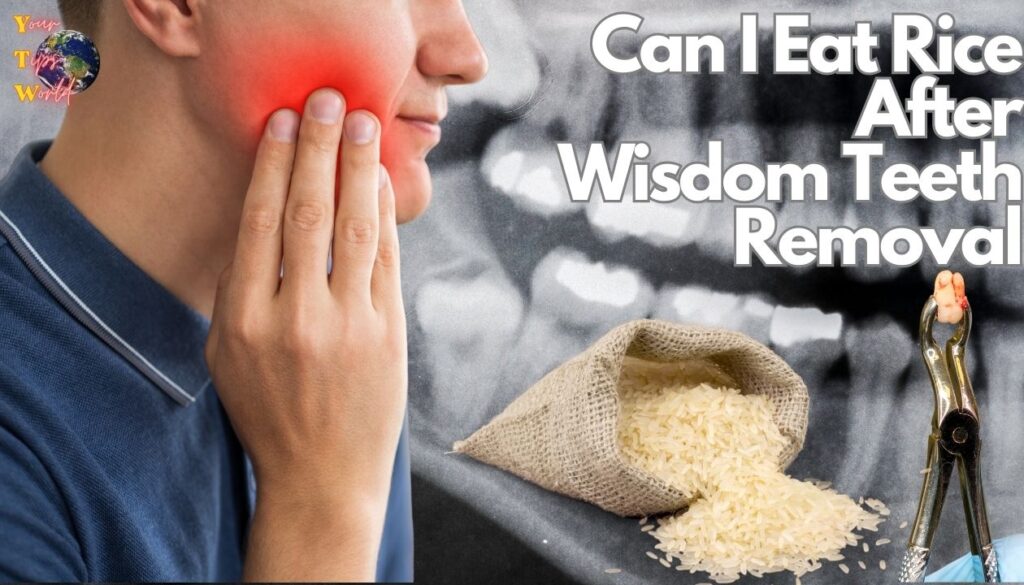Wisdom teeth removal is a common dental surgery that typically requires a period of attentive and strategic recovery.
One of the most pressing questions post-op patients have is about their diet like “Can I Eat Rice After Wisdom Teeth Removal?“.
With your mouth in a delicate state, you must be cautious about what you eat to avoid pain or complications.
This comprehensive guide explores whether rice is a viable dietary option for those who’ve recently had their wisdom teeth extracted and answers ‘Can I Eat Rice After Wisdom Teeth Removal?’.
We’ll delve into the nuances of your post-op diet, the merits of incorporating rice, and additional expert-recommended food choices to facilitate a smoother recuperation.
Understanding the Post-Op Recovery Period
The Healing Process and Timeline
After wisdom teeth removal, the healing process usually unfolds in several phases. The initial phase involves blood clot formation at the extraction site, which is crucial to proper healing and preventing dry socket.
Subsequent phases address tissue granulation and socket closure, providing a foundation for new bone formation.
The timeline for recovery is highly individual, with most patients experiencing initial discomfort and swelling for the first few days.
By the end of the first week, you may observe a discernible improvement in these symptoms. Beyond that, complete tissue healing can take several weeks, and bone healing may continue for months.
Dietary Restrictions and Considerations
Due to the sensitive nature of the healing process, your diet in the days following surgery must consist of soft, non-irritating foods.
The primary objective is to avoid anything that could disrupt the clot or get lodged in the socket, leading to infection or pain.
The ‘Do Not Eat‘ list typically includes:
- Sticky foods like candies or gums
- Crunchy items such as nuts or chips
- Hard food that requires substantial chewing
- Spicy or acidic foods that can irritate the mouth
Beverages with a high sugar content should also be avoided, as well as using straws that can create suction in the mouth.
Can I Eat Rice After Wisdom Teeth Removal and its Benefits
Soft Texture and Easy to Chew
The soft, yielding texture of rice makes it an ideal comfort food during recovery. It’s easily digestible and can be prepared in various ways to suit your current diet.
Whether it’s porridge-like or cooked to a smooth consistency, rice can be consumed without exerting excess pressure on your healing mouth.
Nutritional Value and Energy Boost
Rice is rich in carbohydrates and can provide that much-needed energy when your body is undergoing the taxing task of healing.
This doesn’t mean that recovery is a green light for indulging in high-sugar or high-fat rice dishes.
Opt for healthier preparations to support your system without negatively impacting your recovery.
Risks and Precautions
Potential Issues with Rice and Healing Process
While rice can play a supportive role in your post-op diet, it’s important to be mindful of any risks associated with its consumption.
Some patients may have individual sensitivities or allergies to rice, and others might experience discomfort if the grains aren’t prepared to an adequately soft consistency.
The starch in rice can also be a concern for some, as it might contribute to an accumulation of food particles in the extraction site.
Recommendations for Safe Consumption
To minimize the risks, it’s crucial to prepare rice in a manner that ensures it’s soft and almost creamy for easy ingestion. Advised cooking methods include boiling rice to the point where it’s easily mashed with a fork or blending it with water or broth for a soupy, gentle consistency.
Alternatives to Rice

If rice isn’t your preferred post-wisdom teeth removal staple or if you’re palatably averse to it, there are numerous alternatives that share similar benefits.
Oatmeal, quinoa, couscous, and pasta (cooked until very soft) can offer comparable comfort and nutritional support. Soft fruits like bananas and avocados, as well as cooked and pureed vegetables, can also diversify your soft diet options.
Sample Recovery Diet Plan
A Suggested Meal Plan Incorporating Rice and Other Suitable Foods
- Day 1 to 3: Simple rice porridge, lightly seasoned and cooked to a soft, easy-to-swallow consistency, can be your mainstay for these initial days, alongside a glass of plain water. Extra hydration is vital for the initial recovery period, so make sure to drink plenty of fluids.
- Day 4 to 7: As you begin to feel more comfortable, you can start exploring variations with fluffy, yet well-cooked rice. Mixing with mild vegetable broth or having it as a side with well-steamed, soft vegetables can add nutritional variety without straining your healing mouth.
- Week 2 to 3: Tapering off the ultra-soft preparations, you can move toward dishes where rice is more visibly separated and individually chewable. However, still ensure the grains are very tender and can be easily crushed against the roof of your mouth with your tongue.
- Beyond Week 3: By this time, rice can be a regular part of your diet, but be cautious to avoid uncooked, sticky, or tough varieties. Continue to monitor how your mouth feels and adjust your diet accordingly.
Conclusion
Consider carefully when making the choice to consume rice after wisdom tooth removal in light of your individual recovery and nutritional requirements.
With proper planning and consumption, rice can make an invaluable part of a post-op diet monitored by healthcare providers – with rice serving as one of many post-op options alongside soft fruits and vegetables as vital sources of nourishment for recovery during this critical phase.
Your recovery doesn’t need to be one-note culinary journey either; take this phase as an opportunity to appreciate the nurturing power of simple yet well-considered diets that respect post-op guidelines while being creative within these limits – with any luck your healing experience won’t just be bearable but even satisfying!
Remember every recovery journey is individual;
find what works for you so your road back home becomes as smooth as a perfectly cooked bowl of rice!
For more tips and information, Subscribe to us or keep visiting for new posts.
